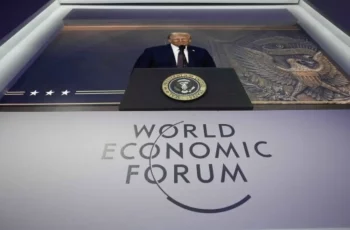
Trump and Putin Agree to Meet Soon
US President Donald Trump and Russian President Vladimir Putin held a phone conversation on Thursday. They agreed to meet soon, probably in Budapest, Hungary. Mr. Trump called the phone call “very productive.” Both leaders agreed there will be a high level meeting, likely the week of October 20th. According to President Trump, the US initial meetings will be led by Secretary of State Marco Rubio, together with various other people, to be designated.

President Trump has called for a ceasefire in Ukraine and an end to the war in that country. Trump’s cabinet officials said they want “any sort of ceasefire.”
The choice of language is important. The Russians have said that a ceasefire in place without conditions would allow Ukraine to build up its arms supplies and recruit more soldiers for the battlefield. Of course, the same is also true for Russia.
But what sort of conditions would be attractive to Putin and Trump? Trump wants the fighting stopped. This is a key point, because it is more than army units fighting on the ground. Also involved are attacks on each other’s territory. The Russians have persistently gone after Ukraine’s critical infrastructure plus some military targets. Likewise, using drones and systems such as Himars, Ukraine has attacked Russia’s infrastructure including refineries, electrical power facilities, rail lines and military targets such as airfields and radar sites. It makes sense that both sides would have to cease mutual attacks of this kind.
The Russians want some sanctions relief, especially respecting oil and gas transit and customers. Trump has singled this sector out to put pressure on the Russian government thinking that Russia’s economy cannot sustain a war without earned income from natural resources. Trump is in a position to trade some or all of the sanctions (and bring Europe into the equation) in exchange for a halt to the fighting.
Once again the two leaders discussed economic cooperation when the war stops.
Russian progress in the war is minimal, mostly thanks to Ukraine’s robust use of drones and Ukraine’s ability to resist. Today Russia controls about 95% of Luhansk, 70% of Donetsk, and parts of Zaphorize and Kherson. Russia has full control over Crimea, and it is likely that a minimal Russian demand is some recognition of these holdings, in particular Crimea.
There are many possible solutions that could resolve the struggle between Ukraine and Russia. As I have previously noted, some or all of the areas annexed by Russia could be turned into long term leaseholds, something like the status of Hong Kong’s 99year lease from China held by the British (until they caved in for commercial reasons and got out early). A solution along these lines could result, over time, in income for Ukraine (land rentals, tariffs etc.) and allow Ukrainian politicians to say they have not “surrendered” any territory to Russia.
On the ground the opposing forces need separation to reduce the risk to the ceasefire because of agreement violations. There are problems given the disposition of both Russian and Ukrainian forces that will need sorting out, if they can be.
NATO’s presence also represents an obstacle for Moscow. While the war itself largely is territorial, NATO’s deep involvement, supplying arms, intelligence, advisors, operators and authoring military strategy, concerns Russia which still regards NATO as a strong adversarial force. Even before the war involved invading Russian troops, both Russia and NATO were positioning for a fight.
It is likely that the Russians somewhat overestimate NATO’s capabilities, but the important point is that they have stood hard and fast on the point they see NATO as threatening them on their most sensitive flank. How can this be changed, if at all?
From a purely military and defense point of view, despite NATO’s engagement in Ukraine, there are no NATO bases in Ukraine. On the other hand, there is no agreement that there will not be any in future. What matters is proximity to Russia’s border and some of its most important towns and cities, as well as its strategic bases.
Russia has quite a number of military bases exposed to possible Ukraine/NATO attacks.
These are:
- Russian Army Southern Military District: The headquarters is in Rostov-on-Don.
- Rostov and Kursk Oblasts: These are key areas for Russian military operations, with forces stationed there and across the border in Ukraine.
- Border regions: Russian forces are concentrated along the border with Ukraine, particularly in areas like Belgorod and Voronezh, ready for operations.
- Airbases: Russia has several airbases near Ukraine, including those in Belgorod and Millerovo, that are used for launching airstrikes and reconnaissance missions.
- Naval bases: In addition to Sevastopol, Russia has other naval bases in the Black Sea region and the Sea of Azov.
- Training and logistical hubs: Russia uses training facilities and logistical hubs in its border regions to support its military operations in Ukraine.
The Russians have not forgotten that NATO helped plan the attacks on Kursk by the Ukrainian army, an attack the Russians did not expect.
As all these bases and operations and command centers are on Russia’s territory, it is understandable Russia worries that NATO’s weapons can be used against them, especially after the costly Kursk debacle. One can add that Russia’s most important cities, Moscow and St. Petersburg also are in range of NATO-supplied weapons.
One solution follows the idea of the now-defunct Intermediate Range Nuclear Forces Treaty (INF). In that agreement the US and Russia agreed to pull back and eliminate certain weapons (SS20, Pershing II). The same sort of deal could be struck on the presence and location of long range systems including HIMARS (ATACMS) and Tomahawk and other long range missiles and heavy drones; the Russians would remove Iskanders (K and M), Kinzhal, Kalibr, Kh-101 and Tsirkon, possibly also Oreshnik. Other systems include Storm Shadow (UK) and Neptune (Ukraine).
A comprehensive agreement would also include long range attack drones such as Ukraine’s Liutyi, FP-1, Beaver and UJ-25, and Russia’s Geran-2, Orion and Inokhodets.
A corollary to reducing the attack weapons portfolio is creating a suitable buffer area which is essential.
The above is presented as preliminary ideas on the ingredients of some sort of ceasefire that could potentially be acceptable to Moscow and Washington. Ukraine would also have to agree, along with the European front-line states (e.g., France, Germany, UK and Poland). Trump would need to sell the package to all these players, a considerable hurdle to a successful outcome.
But some sort of ceasefire can be achieved if the parties want it.
Source: author’s blog










Comments